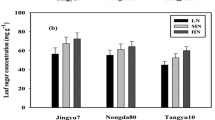Abstract
The effects of redroot pigweed (Amaranthus retroflexus L.) and yellow foxtail [Setariaglauca (L.) Beauv.] residues on corn (Zea mays L.) and soybeans [Glycine max (L.) Merr.] were evaluated at various temperatures and photosynthetic photon flux densities (PPFD) in a Biotron. Mathematical growth analysis techniques were used for the evaluation. Redroot pigweed markedly reduced leaf area duration (LAD), leaf weight ratio (LWR), and total dry matter production in both crops. Yellow foxtail residue inhibited total dry matter production in corn and soybeans 20 and 30 days after planting (DAP). It also reduced growth rate (GR) and LAD in corn and biomass increment (Δ W) in soybeans. Biomass increment was more closely correlated to LAD than net assimilation rate (NAR) in soybeans, whereas in corn NAR contributed more to Δ W than LAD. The 30/20 ° C temperature with a PPFD of 380 μE/m2/sec produced a larger Δ W with a greater NAR and larger LAD in corn, resulting in maximum dry matter accumulation than 20/10 ° C and other levels of PPFD. Under similar conditions, soybeans showed little or no response to the changes. The results demonstrate the allelopathic effects of weed residues on growth and dry matter production, affecting LAD, LWR, and GR. The results also show that environmental temperature and PPFD may alter the allelopathic effects of weeds on crops. The possible interference with photosynthesis and the partitioning of biomass into leaf component relative to the total biomass produced by the plant may be the inhibitory effects of allelochemicals present in redroot pigweed and yellow foxtail residues.
Similar content being viewed by others
References
Bell, D.T., andKoeppe, D.E. 1972. Non-competitive effects of giant foxtail on the growth of corn.Agron. J. 64:321–325.
Bhowmik, P.C. 1981. Allelopathic activity of annual weeds on corn (Zea mays) and soybeans (Glycine max). PhD thesis, Department of Agronomy, University of Wisconsin, Madison, 128 pp.
Bhowmik, P.C., andDoll, J.D. 1979. Evaluation of allelopathic effects of selected weed species on corn (Zea mays) and soybeans (Glycine max).Proc. North Cent. Weed Control Conf. 34:43–45.
Bhowmik, P.C., andDoll, J.D. 1982. Corn and soybean response to allelopathic effects of weed and crop residues.Agron. J. 74:601–606.
Buttery, B.R., andBuzzell, R.I. 1977. The relationship between chlorophyll content and rate of photosynthesis in soybeans.Can. J. Plant Sci. 57:1–5.
Chambers, E.E., andHolm, L.G. 1965. Phosphorous uptake as influenced by associated plants.Weeds 13:312–314.
Cochran, V.L., Elliot, L.F. andPapendick, R.I. 1977. The production of phytotoxins from surface crop residues.Soil Sci. Soc. Am. J. 41:903–908.
Colton, C.E., andEinhellig, F.A. 1980. Allelopathic mechanisms of velvetleaf (Abutilon theophrasti Medic., Malvaceae) on soybean.Am. J. Bot. 67:1407–1413.
Del Moral, R. 1972. On the availability of chlorogenic acid concentration.Oecologia 9:289–300.
Einhellig, F.A., andRasmussen, J.A. 1979. Effects of three phenolic acids on chlorophyll content and growth of soybean and sorghum seedlings.J. Chem. Ecol. 5:815–824.
Einhellig, F.A., Rice, E.L., Risser, P.G., andWender, S.H. 1970. Effects of scopoletin on growth, CO2 exchange rates, and concentration of scopoletin and chlorogenic acids in tobacco, sunflower, and pigweed.Bull. Torrey Bot. Club 97:22–23.
Guenzi, W.D., andMcCalla, T.M. 1966. Phenolic acids in oats, wheat, sorghum, and corn residues and their phytotoxicity.Agron. J. 58:303–304.
Hoagland, D.R., andArnon, D.I. 1950. The water culture method for growing plants without soil.Calif. Agric. Exp. Stn. Circ. No. 547. 32 pp.
Kvet, J., Ondok, J.P., Necas, J., andJarvis, P.G. 1971. Methods of growth analysis, pp. 343–391,in (Z. Sestak, J. Catsky, and P.G. Jarvis, (eds.). Plant Photosynthetic Production. Manual of Methods. W. Junk, The Hague.
Lehman, R.H., andRice, E.L. 1972. Effect of deficiences of nitrogen, potassium, and sulfur on chlorogenic acids and scopoletin in sunflower.Am. Midl. Nat. 87:71–80.
Moore, R.M., Williams, J.D., andChia, J. 1967. Factors affecting concentrations of dimethylated indolealkylamines inPhalaris tuberosa L.Aust. J. Biol. Sci. 20:1131–1140.
Patterson, D.T. 1981. Effects of allelopathic chemicals on growth and physiological responses of soybean (Glycine max).Weed Sci. 29:53–59.
Patterson, D.T., Meyer, C.R., Flint, E.P., andQuimby, P.C., Jr. 1979. Temperature responses and potential distribution of itch-grass (Rottboelliaexaltata) in the United States.Weed Sci. 27:77–82.
Putnam, A.R., andDuke, W.B. 1978. Allelopathy in agroecosystems.Ann. Rev. Phytopathol. 16:431–451.
Radford, P.J. 1967. Growth analysis formulae-their use and abuse.Crop. Sci. 7:171–175.
Rice, E.L. 1974. Allelopathy. Academic Press, New York, 353 pp.
Sprague, H.B., andCurtis, N. 1933. Chlorophyll content as an index of the productive capacity of selected lines of corn and their hybrids.J. Am. Soc. Agron. 25:709–724.
Steel, R.G.D., andTorrie, J.H. 1960. Principles and Procedures of Statistics. McGraw-Hill, New York, 451 pp.
Author information
Authors and Affiliations
Rights and permissions
About this article
Cite this article
Bhowmik, P.C., Doll, J.D. Growth analysis of corn and soybean response to allelopathic effects of weed residues at various temperatures and photosynthetic photon flux densities. J Chem Ecol 9, 1263–1280 (1983). https://doi.org/10.1007/BF00982228
Received:
Revised:
Issue Date:
DOI: https://doi.org/10.1007/BF00982228




